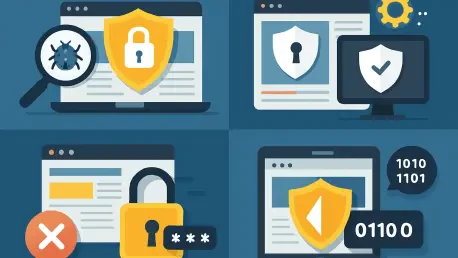In an era where web applications serve as the backbone of nearly every business operation, securing them against an ever-evolving array of cyber threats has become a non-negotiable priority for organizations of all sizes, from small startups to large enterprises. With sophisticated attacks now targeting APIs, runtime vulnerabilities, and even the risks posed by AI-generated code, the stakes for robust protection are higher than ever. The demand for advanced security tools that can keep pace with increasingly complex web ecosystems is at an all-time high. This article explores five leading web security tools designed to safeguard applications from emerging dangers, offering cutting-edge solutions for businesses navigating the digital landscape. Whether managing a vast enterprise network or steering a nimble startup, selecting the right tool can be the difference between resilience and a costly breach. These solutions go beyond merely identifying flaws—they integrate seamlessly into workflows, automate repetitive tasks, and leverage innovative technology to stay ahead of threats. From Dynamic Application Security Testing (DAST) to AI-driven insights, the focus here is on the tools shaping the forefront of web protection.
The Growing Importance of Web Security
The digital environment today is marked by unprecedented complexity and rapid innovation, with businesses increasingly relying on intricate web architectures like Single Page Applications (SPAs), heavy JavaScript frameworks, and diverse API structures. This expansion significantly broadens the attack surface, creating new opportunities for cybercriminals to exploit vulnerabilities. Additionally, the rise of AI-generated code introduces unique risks that traditional security measures often fail to address. Modern tools must provide real-time visibility into threats and offer intelligent remediation strategies to prevent breaches before they occur. Without such capabilities, organizations risk falling behind in a landscape where speed and adaptability are paramount. The urgency to adopt comprehensive security solutions is driven by the need to protect sensitive data and maintain customer trust amid growing regulatory scrutiny and sophisticated attack methods.
Beyond the technical challenges, the financial and reputational consequences of a security breach can be devastating for any organization. A single incident can lead to significant downtime, loss of revenue, and long-term damage to brand credibility, making proactive defense a critical investment. Security tools today are expected to do more than just scan for vulnerabilities—they must align with business goals by minimizing disruptions and ensuring compliance with standards like PCI DSS. As cyber threats continue to evolve, the emphasis on dynamic testing and runtime protection becomes essential. The tools highlighted in this discussion are designed to address these multifaceted challenges, providing a robust shield against both current and emerging dangers. Their ability to adapt to new technologies and threat patterns ensures that businesses can operate with confidence in a highly connected world.
Precision Through Automation and Accuracy
One of the defining features of leading security tools is their commitment to automation and precision, which directly tackles the challenge of managing vast numbers of potential threats. Tools such as Invicti and Acunetix stand out with near-perfect accuracy rates, achieving up to 99.98% in vulnerability validation. This high level of precision drastically reduces the occurrence of false positives, a persistent issue that can overwhelm security teams and dilute focus from genuine risks. By automating the detection and validation processes, these solutions enable professionals to prioritize critical issues without wasting resources on irrelevant alerts. This efficiency is particularly vital for organizations managing large portfolios of applications, where manual oversight becomes impractical.
Furthermore, the reduction of alert fatigue through automation allows security personnel to maintain sharper focus on strategic tasks rather than sifting through endless notifications. The streamlined approach not only saves time but also enhances the overall effectiveness of security operations. For instance, Veracode boasts a false positive rate of less than 5%, ensuring that teams can trust the alerts they receive. This level of reliability transforms how vulnerabilities are managed, shifting the paradigm from reactive firefighting to proactive prevention. As cyber threats grow in sophistication, the ability to automate with accuracy provides a competitive edge, allowing businesses to stay ahead of potential breaches while maintaining operational momentum. The emphasis on precision in these tools reflects a broader industry trend toward smarter, more efficient security practices.
Embedding Security in DevSecOps Workflows
A critical strength of today’s top security tools lies in their seamless integration with DevSecOps practices, ensuring that protection is embedded throughout the software development lifecycle (SDLC). Compatibility with Continuous Integration/Continuous Deployment (CI/CD) pipelines and platforms like Jenkins, GitHub, and Jira is a hallmark of tools such as Burp Suite and Checkmarx. This integration allows security checks to occur early and often, aligning with the fast-paced nature of agile development. By making security a shared responsibility between development and operations teams, these tools help eliminate the traditional silos that often delay threat identification and remediation. The result is a smoother workflow where updates can be released swiftly without compromising safety.
Additionally, the focus on DevSecOps integration addresses the growing need for collaboration in modern business environments. Tools that provide unified dashboards and developer-friendly remediation guidance, like those offered by Checkmarx, reduce friction between teams and foster a culture of shared accountability. This approach ensures that security is not treated as an afterthought but as a core component of every development phase. The ability to automate security scans within CI/CD pipelines also means that vulnerabilities can be caught and addressed before they reach production, minimizing risks. As organizations strive to balance speed and safety, the role of these tools in bridging development and security becomes indispensable, paving the way for more resilient applications in a competitive digital space.
Support for Evolving Web Architectures
Adaptability to modern web technologies is a distinguishing feature of the leading security tools, ensuring they can protect the diverse architectures that define today’s digital landscape. Solutions like Invicti and Acunetix are specifically engineered to handle dynamic environments, including SPAs, JavaScript-heavy sites, and various API types such as REST, SOAP, and GraphQL. This capability is crucial as web ecosystems become more intricate, with unique tech stacks often creating blind spots for traditional security measures. By offering comprehensive coverage across these platforms, these tools ensure that vulnerabilities are not overlooked simply due to unconventional design or implementation, providing a robust defense against exploitation.
Moreover, compliance with regulatory standards adds another layer of relevance to these tools, particularly for industries handling sensitive data. Invicti, for instance, maps vulnerabilities to requirements like PCI DSS, helping organizations meet legal and industry obligations without additional overhead. This dual focus on technological adaptability and regulatory alignment makes such tools indispensable for businesses navigating complex operational landscapes. As the diversity of web applications continues to grow, the ability to secure every component—regardless of its structure—becomes a fundamental requirement. These solutions not only address current needs but also anticipate future shifts in web development, ensuring long-term protection against an expanding array of threats.
Harnessing AI for Proactive Threat Detection
The integration of AI and machine learning into security tools marks a transformative shift in how threats are identified and mitigated, offering a proactive edge in an increasingly hostile digital environment. Tools like Checkmarx and Invicti utilize AI for predictive risk scoring and runtime protection, addressing emerging concerns such as vulnerabilities in AI-generated code—a significant issue as automated coding practices gain traction. This intelligent approach allows for the anticipation of threats rather than merely reacting to them, a critical advantage when dealing with sophisticated attacks. By prioritizing risks based on exploitability, these tools enable security teams to focus on the most pressing dangers, enhancing overall defense strategies.
In addition to predictive capabilities, AI-driven features streamline remediation processes by providing actionable insights tailored to specific vulnerabilities. This reduces the time and expertise needed to address complex issues, making security more accessible even to teams with limited resources. The focus on runtime visibility further ensures that threats are detected in real-time, minimizing the window of opportunity for attackers. As cyber risks evolve, the incorporation of AI into security solutions represents a forward-thinking trend that aligns with the need for smarter, more adaptive defenses. Organizations adopting these tools gain not only immediate protection but also a framework for addressing future challenges, ensuring resilience in a landscape defined by constant change.
Matching Tools to Organizational Needs
Recognizing that no single solution fits every organization, the diversity among these security tools allows for tailored selections based on specific requirements and constraints. Enterprise-grade platforms like Invicti and Veracode offer scalable, cloud-native environments ideal for large organizations with extensive application portfolios. These tools provide comprehensive Application Security (AppSec) platforms that integrate multiple testing methodologies, ensuring thorough protection. Conversely, Acunetix focuses on affordability and ease of use, making it a preferred choice for small-to-medium businesses (SMBs) that need effective security without overwhelming complexity. This segmentation ensures that businesses of all sizes can find a tool that aligns with their operational scale.
Beyond size, technical and budgetary considerations play a significant role in tool selection. Burp Suite, with its customizable automation, appeals to organizations seeking flexibility in large-scale environments, though it may require more expertise to maximize its potential. Checkmarx, on the other hand, excels with AI-ready features, particularly for addressing risks from automated code, positioning it as a leader for forward-thinking enterprises. The key takeaway is that choosing a tool involves a careful evaluation of an organization’s unique needs, from integration capabilities to cost structures. By matching solutions to specific demands, businesses can build a security posture that not only addresses current threats but also scales with future growth, ensuring sustained protection in a dynamic digital era.
Building a Secure Digital Future
Reflecting on the landscape of web security, it’s evident that the tools discussed—Invicti, Acunetix, Burp Suite, Checkmarx, and Veracode—play a pivotal role in addressing the multifaceted challenges organizations face. Their emphasis on automation, integration with DevSecOps, and adaptability to modern web technologies provides a strong foundation for defending against sophisticated cyber threats. The incorporation of AI-driven capabilities by some of these solutions marks a significant step toward proactive threat management, particularly in handling risks from emerging areas like AI-generated code. Each tool brings distinct strengths to the table, catering to a range of organizational needs from enterprise scalability to SMB accessibility.
Looking ahead, the path to sustained security involves actionable steps that build on these advancements. Organizations are encouraged to begin with free trials or open-source options to assess their specific requirements before committing to a solution. Prioritizing tools with robust DevSecOps integration ensures alignment with development goals, while adopting AI-enhanced features offers a forward-looking defense against evolving threats. The focus shifts to continuous evaluation and adaptation, ensuring that security measures remain relevant as digital landscapes transform. By aligning tool selection with unique operational demands, businesses can establish a resilient framework for protecting their applications against the unpredictable nature of cyber risks.









